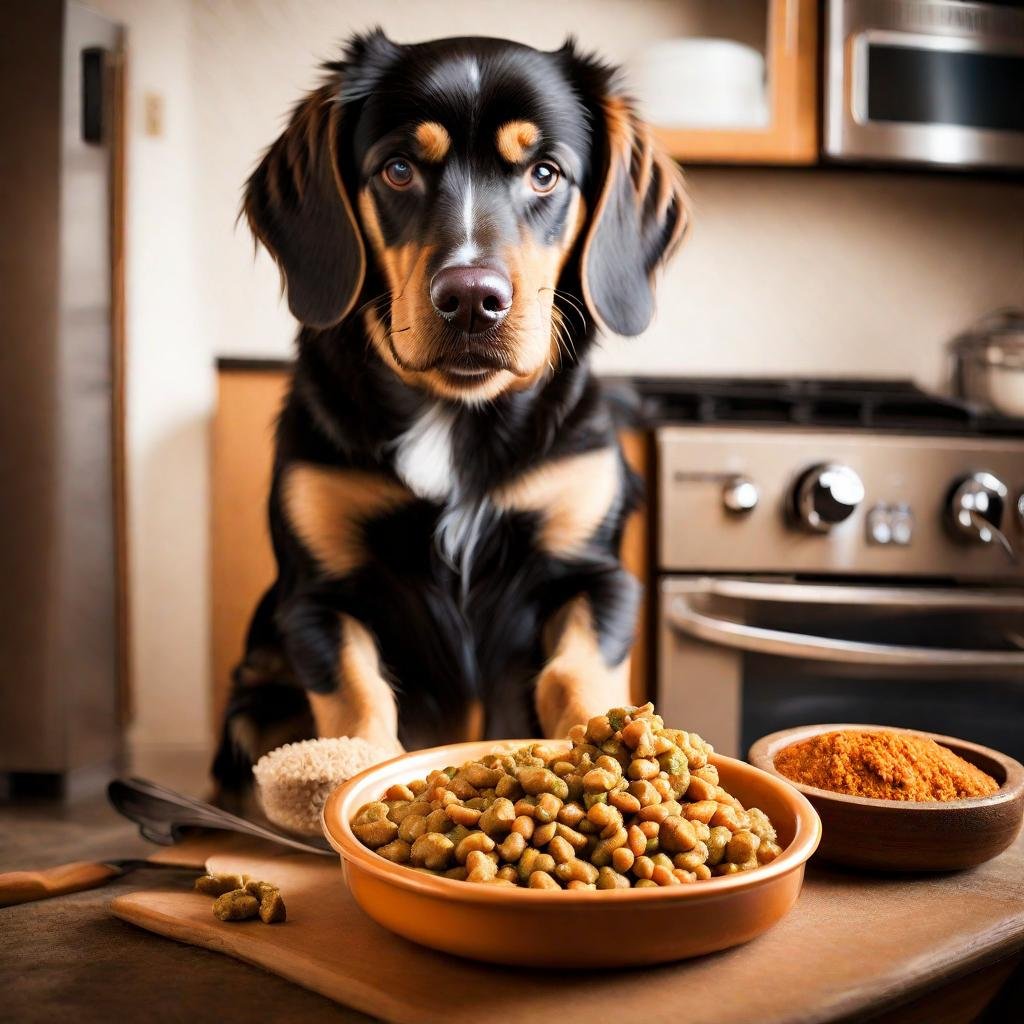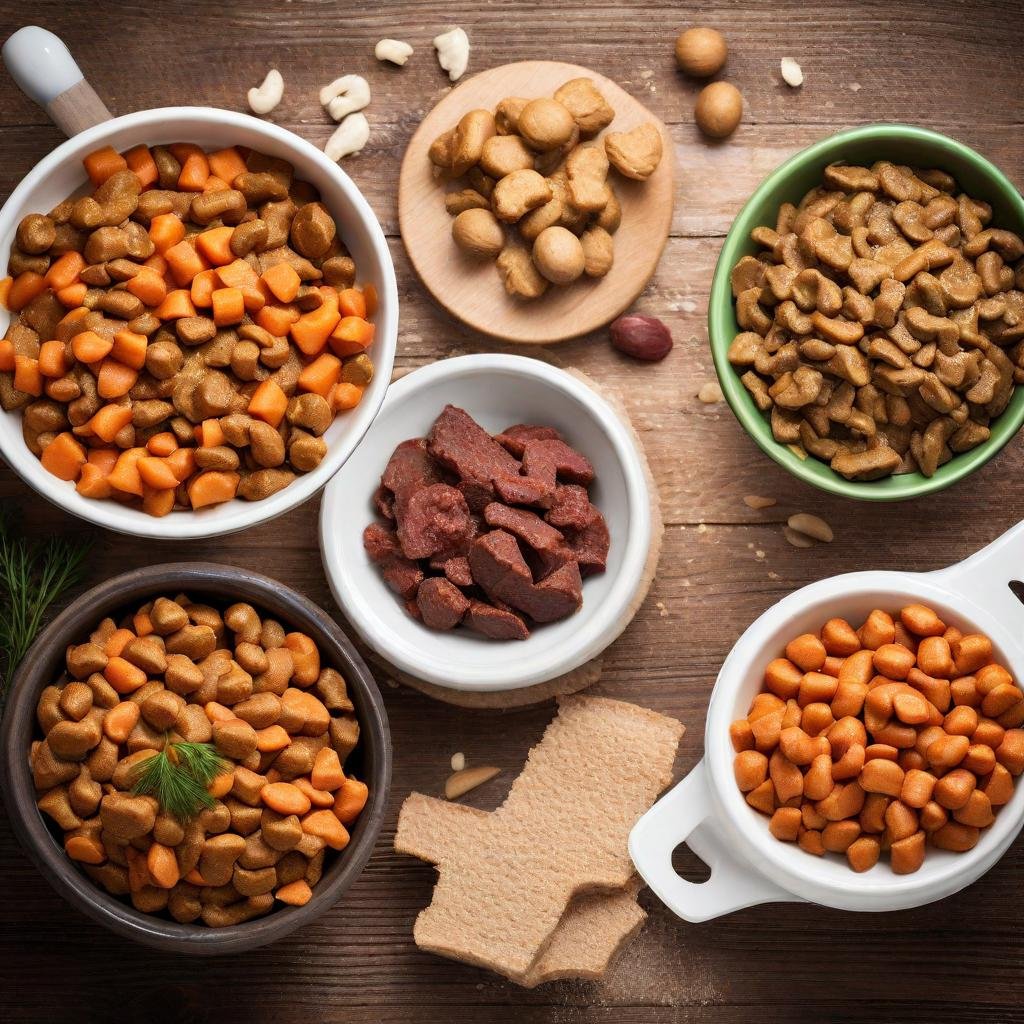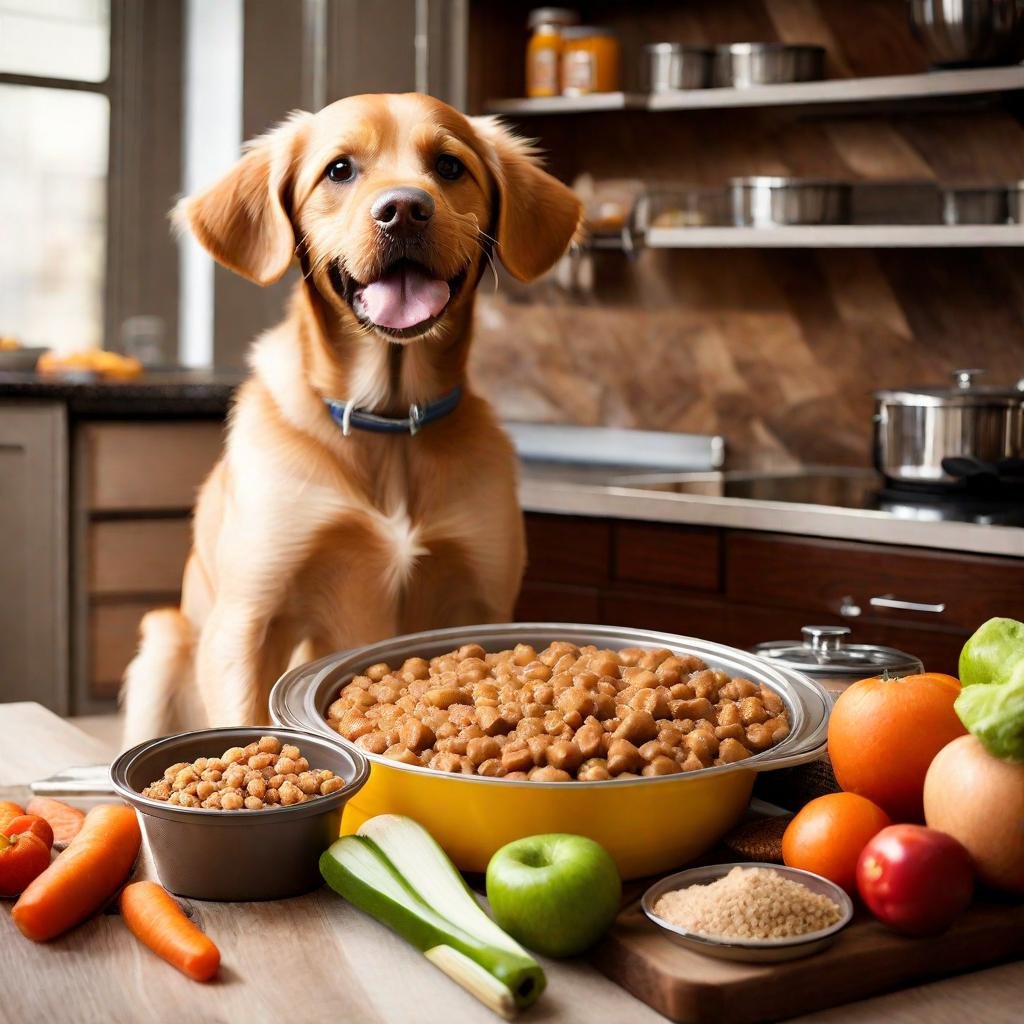“Tailoring Portion Control: Crafting the Perfect Homemade Diet for Your Pooch”
##Introduction to Homemade Dog Food##
Welcome to the ultimate guide on crafting the perfect homemade diet for your beloved furry friend! Today, we’re diving into the age-old question: “How much homemade dog food to feed?” As pet owners, we want nothing but the best for our loyal companions, and nutrition plays a pivotal role in their health and happiness.

Table of Contents
Picture this: you’re in your kitchen, whipping up a batch of nutritious goodness for your dog, but suddenly, you find yourself pondering, “Am I feeding too much or too little?” Don’t worry; you’re not alone in this quest for portion perfection!
Understanding how much homemade dog food to feed can feel like navigating a maze, but fear not! In this guide, we’ll unravel the mystery behind portion control and empower you to tailor your dog’s diet to their unique needs.

Whether you’re a seasoned pro or just dipping your toes into the world of homemade dog food, this guide is your go-to resource for ensuring your canine companion receives the nourishment they deserve. So, grab a treat for your pup, cozy up, and let’s embark on this culinary journey together!
## 1 of 8 ## Understanding Your Dog’s Nutritional Needs :
When it comes to nourishing our furry friends, it’s essential to grasp the basics of their nutritional requirements. Dogs, much like us, thrive on a balanced diet tailored to their specific needs. Let’s break it down:
1. Essential Nutrients:
Just like humans, dogs require a variety of nutrients to stay healthy. These include proteins, carbohydrates, fats, vitamins, and minerals. Each plays a crucial role in your dog’s overall well-being.
2. Protein Power:
Protein is vital for your dog’s muscle development, immune function, and energy levels. High-quality protein sources, such as lean meats and fish, should be the cornerstone of their diet.
3. Carbohydrate Considerations:
Carbohydrates provide a source of energy for your pup. Opt for wholesome options like whole grains and vegetables to ensure a steady release of energy throughout the day.
4. Healthy Fats:
Fats are essential for maintaining healthy skin and coat, as well as supporting various bodily functions. Incorporate sources of omega-3 and omega-6 fatty acids, such as salmon and flaxseed oil, into their diet.
5. Vitamin and Mineral Must-Haves:
These micronutrients are crucial for your dog’s overall health. From vitamin A for vision to calcium for strong bones, ensuring a diverse array of vitamins and minerals is key.
Understanding your dog’s nutritional needs lays the foundation for determining how much homemade dog food to feed. By providing a well-balanced diet rich in essential nutrients, you’re setting your pup up for a lifetime of vitality and tail-wagging happiness!
## 2 of 8 ## Factors Influencing How much homemade dog food to feed :
Factors Influencing How Much Homemade Dog Food to Feed
Feeding your furry friend isn’t a one-size-fits-all endeavor. Several factors come into play when determining the right amount of homemade dog food to serve. Let’s explore these factors together:
1. Size Matters:
Larger breeds generally require more food than their smaller counterparts due to their higher metabolism and energy needs. Consider your dog’s size when portioning their meals.
2. Age and Life Stage:
Puppies, adult dogs, and seniors have varying nutritional requirements. Puppies, for instance, need more calories and nutrients to support their rapid growth and development.
3. Activity Level:
Just like humans, dogs who lead active lifestyles burn more calories and require additional nourishment. Working dogs, athletes, and high-energy breeds may need larger portions to fuel their adventures.

4. Metabolism:
Each dog’s metabolism is unique. Some dogs may have a naturally faster metabolism and require more food to maintain their weight, while others may need less.
5. Health Considerations:
Health conditions, such as obesity or underlying medical issues, can influence how much food your dog needs. Work closely with your veterinarian to tailor their diet accordingly.
By considering these factors, you can better gauge how much homemade dog food to feed your furry companion. Remember, every dog is different, so it may take some trial and error to find the perfect portion size that keeps them happy, healthy, and thriving!
## 3 of 8 ## Determining Your Dog’s Ideal Weight :
Determining Your Dog’s Ideal Weight
Ensuring your dog maintains a healthy weight is vital for their overall well-being. Let’s explore how to determine your furry friend’s ideal weight and why it’s crucial:
1. Visual Assessment:
Start by visually assessing your dog’s body condition. A healthy dog should have a visible waist when viewed from above and a slight tuck-up in their abdomen when viewed from the side.
2. Hands-On Approach:
Run your hands along your dog’s ribcage. You should be able to feel their ribs with slight padding over them. If ribs are easily felt with no excess fat covering, your dog is likely at a healthy weight.

3. Utilize Weight Charts:
Breed-specific weight charts can provide a general guideline for determining your dog’s ideal weight range. However, remember that individual variation exists within breeds.
4. Regular Weigh-Ins:
Schedule regular weigh-ins with your veterinarian to track your dog’s weight over time. This helps detect any fluctuations that may indicate health issues.
5. Adjusting Diet:
If your dog is under or overweight, adjusting their diet is crucial. Your veterinarian can provide personalized recommendations on portion sizes and nutrient intake.
By accurately determining your dog’s ideal weight, you can better assess how much homemade dog food to feed them, ensuring they stay healthy, happy, and full of vitality!
## 4 of 8 ## Calculating Daily Calories Needs :
Calculating Your Dog’s Daily Caloric Needs
Understanding how many calories your dog requires each day is essential for maintaining their optimal health and weight. Let’s break down the process in simple steps:
1. Assessing Basal Metabolic Rate (BMR):
Similar to humans, your dog’s BMR is the number of calories they need to sustain basic bodily functions while at rest. Factors such as age, weight, and activity level influence their BMR.

2. Activity Level Evaluation:
Determine your dog’s activity level using a scale from sedentary to highly active. This helps adjust their calorie needs based on their daily exercise regimen.
3. Calculating Maintenance Calories:
Multiply your dog’s BMR by their activity factor to estimate their daily maintenance calories. This accounts for the energy expended during daily activities.
4.Consider Life Stage:
Puppies, pregnant or nursing dogs, and seniors may have different calorie requirements. Adjust their calorie intake accordingly to support their specific needs.
5. Monitoring Weight:
Regularly monitor your dog’s weight and adjust their calorie intake as needed to maintain a healthy weight.
By calculating your dog’s daily calorie needs accurately, you can determine how much homemade dog food to feed them, ensuring they receive the right balance of nutrients to thrive each day.
## 5 of 8 ## Guidelines for Portion Sizes :
When it comes to feeding your furry friend, getting the portion sizes right is crucial for their health and well-being. Here’s a simple guide to help you determine the perfect portions:

1. Body Weight Consideration:
Start by considering your dog’s current weight. Portion sizes should be based on their ideal weight, not their current weight, especially if they need to gain or lose a few pounds.
2. Caloric Needs:
Calculate your dog’s daily caloric needs based on factors like age, activity level, and metabolism. This helps ensure they receive the right amount of energy to fuel their day.
3. Food Type:
Different types of homemade dog food may have different calorie densities. Be mindful of this when portioning their meals, and adjust accordingly.
4. Divide into Meals:
Split your dog’s daily food allowance into multiple meals throughout the day. This helps prevent overeating and keeps their metabolism steady.
5. Monitor and Adjust:
Keep an eye on your dog’s body condition and adjust portion sizes as needed. If they’re gaining or losing weight, it may be necessary to tweak their portions accordingly.
By following these guidelines for portion sizes, you can ensure that your furry companion receives the right amount of homemade dog food to meet their nutritional needs and keep them healthy and happy.
## 6 of 8 ## Adjusting Portions Based on Activity Level and Life Stage :
Just like humans, dogs’ nutritional needs vary depending on their activity level and life stage. Here’s how to tailor their portions for optimal health:

1. Active Pups:
High-energy breeds and active dogs burn more calories and require larger portions to fuel their adventures. Consider increasing their portion sizes to match their energy output.
2. Senior Dogs:
As dogs age, their metabolism slows down, and they may become less active. Adjust their portions accordingly to prevent weight gain and maintain muscle mass.
3. Puppies:
Growing puppies have high energy needs to support their rapid development. Feed them smaller, more frequent meals to accommodate their small stomachs and ensure they receive adequate nutrition.
4. Pregnant or Nursing Dogs:
Expectant or lactating mothers have increased energy requirements to support themselves and their growing pups. Consult with your veterinarian to determine the appropriate portion sizes for this crucial life stage.
5. Monitor and Adjust:
Keep an eye on your dog’s weight and body condition and adjust their portions as needed. Regular monitoring ensures they receive the right amount of homemade dog food to thrive at every stage of life.
## 7 of 8 ## Monitoring Your Dog’s Body Condition :

Keeping a close eye on your dog’s body condition is essential for ensuring they stay healthy and happy. Here’s how to monitor their body condition effectively:
1.Visual Assessment:
Regularly inspect your dog’s body for signs of obesity or undernourishment. Look for a defined waistline and a visible outline of their ribs without excessive fat covering.
2. Hands-On Approach:
Run your hands over your dog’s body, feeling for their ribs, spine, and hip bones. You should be able to feel these bones without pressing too hard, indicating a healthy weight.
3. Weigh-Ins:
Schedule regular weigh-ins with your veterinarian to track your dog’s weight over time. Sudden changes in weight can signal health issues or indicate that adjustments to their diet are needed.
4. Behavioral Cues:
Pay attention to your dog’s behavior and energy levels. Changes in appetite, lethargy, or excessive hunger could indicate that they’re not getting enough or too much food.

5. Adjustments as Needed:
Based on your observations, adjust your dog’s portion sizes accordingly to maintain their ideal body condition. Consult with your veterinarian for personalized recommendations if needed.
By monitoring your dog’s body condition closely, you can ensure they receive the right amount of homemade dog food to keep them healthy and thriving for years to come.
## 8 of 8 ## Common Mistakes to Avoid When Feeding Homemade Dog Food :
While preparing homemade dog food can be a rewarding experience, there are several common pitfalls to watch out for. Here’s how to avoid them:
1. Inadequate Nutrition:
One of the biggest mistakes is not providing a balanced diet. Homemade dog food should contain a variety of proteins, carbohydrates, fats, vitamins, and minerals to meet your pup’s nutritional needs.
2. Incorrect Portioning:
Overfeeding or underfeeding can lead to weight issues and nutritional deficiencies. Follow portion guidelines based on your dog’s size, activity level, and life stage to ensure they receive the right amount of food.
3. Lack of Variety:
Dogs benefit from a diverse diet just like humans. Rotate protein sources and include a variety of vegetables and grains to provide essential nutrients and prevent boredom.
4. Missing Supplements:
Homemade diets may lack certain vitamins and minerals, especially if they’re not properly balanced. Consult with a veterinarian to determine if supplements are needed to fill any nutritional gaps.

5. Unsafe Ingredients:
Some foods, such as onions, grapes, and chocolate, can be toxic to dogs. Avoid using ingredients that are harmful to your furry friend’s health.
By avoiding these common mistakes, you can ensure that your homemade dog food provides the right balance of nutrients and keeps your canine companion healthy and happy.
## Conclusion ##
Providing Balanced Nutrition for Your Furry Friend
Feeding your dog a homemade diet is a wonderful way to show them love and care, but it comes with the responsibility of ensuring they receive balanced nutrition. By following the guidelines outlined in this guide, you can provide your furry friend with the nourishment they need to thrive.
Remember to consider factors like your dog’s size, activity level, and life stage when determining how much homemade dog food to feed. Monitoring their body condition and adjusting portions as needed ensures they maintain a healthy weight and optimal health.

Avoid common mistakes such as inadequate nutrition, incorrect portioning, and unsafe ingredients to keep your pup safe and healthy. By offering a variety of protein sources, carbohydrates, fats, vitamins, and minerals, you can ensure they receive a well-rounded diet.
Consulting with your veterinarian and staying informed about your dog’s nutritional needs are essential for their well-being. With proper care and attention to their diet, you can provide your furry friend with a long, happy, and healthy life filled with tail wags and puppy kisses.
You can read this post Healthiest Dog Food
“Tailoring Portion Control: Crafting the Perfect Homemade Diet for Your Pooch” ##Introduction to Homemade Dog Food## Welcome to the ultimate guide on crafting the perfect homemade diet for your beloved furry friend! Today, we’re diving into the age-old question: “How much homemade dog food to feed?” As pet owners, we want nothing but the best…
How do I know if I’m feeding my dog the right amount of homemade food?

Monitoring your dog’s body condition, energy levels, and weight is key. Consult with your veterinarian for personalized recommendations based on your dog’s individual needs.
Can I feed my dog the same homemade food every day?

While consistency is important, it’s essential to provide variety in your dog’s diet to ensure they receive a wide range of nutrients. Rotate protein sources and include different fruits, vegetables, and grains to keep their meals interesting and nutritious.
Should I add supplements to my dog’s homemade diet?

Supplements may be necessary to fill any nutritional gaps in your dog’s homemade diet. Consult with your veterinarian to determine if supplements such as vitamins or minerals are needed based on your dog’s specific needs and diet.
Can I prepare homemade dog food in bulk and freeze it?

Yes, preparing homemade dog food in bulk and freezing it can be convenient and cost-effective. Ensure proper portioning and storage to maintain freshness and nutritional quality.
How often should I adjust my dog’s portion sizes?

Regularly monitor your dog’s body condition and weight. Adjust portion sizes as needed to maintain their ideal weight and overall health. If you’re unsure, consult with your veterinarian for guidance.
